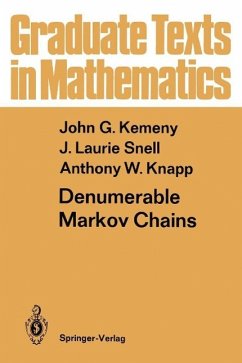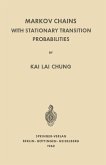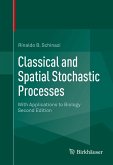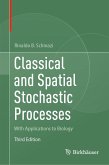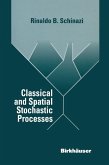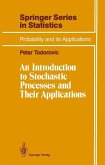John G. Kemeny, J. Laurie Snell, Anthony W. Knapp
Denumerable Markov Chains (eBook, PDF)
with a chapter of Markov Random Fields by David Griffeath
52,95 €
52,95 €
inkl. MwSt.
Sofort per Download lieferbar

26 °P sammeln
52,95 €
Als Download kaufen

52,95 €
inkl. MwSt.
Sofort per Download lieferbar

26 °P sammeln
Jetzt verschenken
Alle Infos zum eBook verschenken
52,95 €
inkl. MwSt.
Sofort per Download lieferbar
Alle Infos zum eBook verschenken

26 °P sammeln
John G. Kemeny, J. Laurie Snell, Anthony W. Knapp
Denumerable Markov Chains (eBook, PDF)
with a chapter of Markov Random Fields by David Griffeath
- Format: PDF
- Merkliste
- Auf die Merkliste
- Bewerten Bewerten
- Teilen
- Produkt teilen
- Produkterinnerung
- Produkterinnerung

Bitte loggen Sie sich zunächst in Ihr Kundenkonto ein oder registrieren Sie sich bei
bücher.de, um das eBook-Abo tolino select nutzen zu können.
Hier können Sie sich einloggen
Hier können Sie sich einloggen
Sie sind bereits eingeloggt. Klicken Sie auf 2. tolino select Abo, um fortzufahren.

Bitte loggen Sie sich zunächst in Ihr Kundenkonto ein oder registrieren Sie sich bei bücher.de, um das eBook-Abo tolino select nutzen zu können.
This textbook provides a systematic treatment of denumerable Markov chains, covering both the foundations of the subject and some in topics in potential theory and boundary theory. The book is a careful exposition with special emphasis on the clarity of style and presentation.
- Geräte: PC
- ohne Kopierschutz
- eBook Hilfe
- Größe: 36.18MB
Andere Kunden interessierten sich auch für
![Markov Chains with Stationary Transition Probabilities (eBook, PDF) Markov Chains with Stationary Transition Probabilities (eBook, PDF)]() Kai Lai ChungMarkov Chains with Stationary Transition Probabilities (eBook, PDF)40,95 €
Kai Lai ChungMarkov Chains with Stationary Transition Probabilities (eBook, PDF)40,95 €![Classical and Spatial Stochastic Processes (eBook, PDF) Classical and Spatial Stochastic Processes (eBook, PDF)]() Rinaldo B. SchinaziClassical and Spatial Stochastic Processes (eBook, PDF)46,95 €
Rinaldo B. SchinaziClassical and Spatial Stochastic Processes (eBook, PDF)46,95 €![Stochastic Processes in Quantum Physics (eBook, PDF) Stochastic Processes in Quantum Physics (eBook, PDF)]() Masao NagasawaStochastic Processes in Quantum Physics (eBook, PDF)112,95 €
Masao NagasawaStochastic Processes in Quantum Physics (eBook, PDF)112,95 €![Markov Chains (eBook, PDF) Markov Chains (eBook, PDF)]() Kai Lai ChungMarkov Chains (eBook, PDF)88,95 €
Kai Lai ChungMarkov Chains (eBook, PDF)88,95 €![Classical and Spatial Stochastic Processes (eBook, PDF) Classical and Spatial Stochastic Processes (eBook, PDF)]() Rinaldo B. SchinaziClassical and Spatial Stochastic Processes (eBook, PDF)52,95 €
Rinaldo B. SchinaziClassical and Spatial Stochastic Processes (eBook, PDF)52,95 €![Classical and Spatial Stochastic Processes (eBook, PDF) Classical and Spatial Stochastic Processes (eBook, PDF)]() Rinaldo B. SchinaziClassical and Spatial Stochastic Processes (eBook, PDF)40,95 €
Rinaldo B. SchinaziClassical and Spatial Stochastic Processes (eBook, PDF)40,95 €![An Introduction to Stochastic Processes and Their Applications (eBook, PDF) An Introduction to Stochastic Processes and Their Applications (eBook, PDF)]() Petar TodorovicAn Introduction to Stochastic Processes and Their Applications (eBook, PDF)96,95 €
Petar TodorovicAn Introduction to Stochastic Processes and Their Applications (eBook, PDF)96,95 €-
-
-
This textbook provides a systematic treatment of denumerable Markov chains, covering both the foundations of the subject and some in topics in potential theory and boundary theory. The book is a careful exposition with special emphasis on the clarity of style and presentation.
Dieser Download kann aus rechtlichen Gründen nur mit Rechnungsadresse in A, B, BG, CY, CZ, D, DK, EW, E, FIN, F, GR, HR, H, IRL, I, LT, L, LR, M, NL, PL, P, R, S, SLO, SK ausgeliefert werden.
Produktdetails
- Produktdetails
- Verlag: Springer US
- Seitenzahl: 484
- Erscheinungstermin: 6. Dezember 2012
- Englisch
- ISBN-13: 9781468494556
- Artikelnr.: 43988317
- Verlag: Springer US
- Seitenzahl: 484
- Erscheinungstermin: 6. Dezember 2012
- Englisch
- ISBN-13: 9781468494556
- Artikelnr.: 43988317
- Herstellerkennzeichnung Die Herstellerinformationen sind derzeit nicht verfügbar.
1: Prerequisites from Analysis.
1. Denumerable Matrices.
2. Measure Theory.
3. Measurable Functions and Lebesgue Integration.
4. Integration Theorems.
5. Limit Theorems for Matrices.
6. Some General Theorems from Analysis.
2: Stochastic Processes.
1. Sequence Spaces.
2. Denumerable Stochastic Processes.
3. Borel Fields in Stochastic Processes.
4. Statements of Probability Zero or One.
5. Conditional Probabilities.
6. Random Variables and Means.
7. Means Conditional on Statements.
8. Problems.
3: Martingales.
1. Means Conditional on Partitions and Functions.
2. Properties of Martingales.
3. A First Martingale Systems Theorem.
4. Martingale Convergence and a Second Systems Theorem.
5. Examples of Convergent Martingales.
6. Law of Large Numbers.
7. Problems.
4: Properties of Markov Chains.
1. Markov Chains.
2. Examples of Markov Chains.
3. Applications of Martingale Ideas.
4. Strong Markov Property.
5. Systems Theorems for Markov Chains.
6. Applications of Systems Theorems.
7. Classification of States.
8. Problems.
5: Transient Chains.
1. Properties of Transient Chains.
2. Superregular Functions.
3. Absorbing Chains.
4. Finite Drunkard's Walk.
5. Infinite Drunkard's Walk.
6. A Zero
One Law for Sums of Independent Random Variables.
7. Sums of Independent Random Variables on the Line.
8. Examples of Sums of Independent Random Variables.
9. Ladder Process for Sums of Independent Random Variables.
10. The Basic Example.
11. Problems.
6: Recurrent Chains.
1. Mean Ergodic Theorem for Markov Chains.
2. Duality.
3. Cyclicity.
4. Sums of Independent Random Variables.
5. Convergence Theorem for Noncyclic Chains.
6. Mean First Passage Time Matrix.
7. Examples of the Mean First Passage Time Matrix.
8. Reverse Markov Chains.
9.Problems.
7: Introduction to Potential Theory.
1. Brownian Motion.
2. Potential Theory.
3. Equivalence of Brownian Motion and Potential Theory.
4. Brownian Motion and Potential Theory in n Dimensions.
5. Potential Theory for Denumerable Markov Chains.
6. Brownian Motion as a Limit of the Symmetric Random Walk.
7. Symmetric Random Walk in n Dimensions.
8: Transient Potential Theory.
1. Potentials.
2. The h
Process and Some Applications.
3. Equilibrium Sets and Capacities.
4. Potential Principles.
5. Energy.
6. The Basic Example.
7. An Unbounded Potential.
8. Applications of Potential
Theoretic Methods.
9. General Denumerable Stochastic Processes.
10. Problems.
9: Recurrent Potential Theory.
1. Potentials.
2. Normal Chains.
3. Ergodic Chains.
4. Classes of Ergodic Chains.
5. Strong Ergodic Chains.
6. The Basic Example.
7. Further Examples.
8. The Operator K.
9. Potential Principles.
10. A Model for Potential Theory.
11. A Nonnormal Chain and Other Examples.
12. Two
Dimensional Symmetric Random Walk.
13. Problems.
10: Transient Boundary Theory.
1. Motivation for Martin Boundary Theory.
2. Extended Chains.
3. Martin Exit Boundary.
4. Convergence to the Boundary.
5. Poisson
Martin Representation Theorem.
6. Extreme Points of the Boundary.
7. Uniqueness of the Representation.
8. Analog of Fatou's Theorem.
9. Fine Boundary Functions.
10. Martin Entrance Boundary.
11. Application to Extended Chains.
12. Proof of Theorem 10.9.
13. Examples.
14. Problems.
11: Recurrent Boundary Theory.
1. Entrance Boundary for Recurrent Chains.
2. Measures on the Entrance Boundary.
3. Harmonic Measure for Normal Chains.
4. Continuous and T
Continuous Functions.
5. Normal Chains and Convergence to the Boundary.
6. Representation Theorem.
7. Sums of Independent Random Variables.
8. Examples.
9. Problems.
12: Introduction to Random Fields.
1 Markov Fields.
2. Finite Gibbs Fields.
3. Equivalence of Finite Markov and Neighbor Gibbs Fields.
4. Markov Fields and Neighbor Gibbs Fields: the Infinite Case.
5. Homogeneous Markov Fields on the Integers.
6. Examples of Phase Multiplicity in Higher Dimensions.
7. Problems.
Notes.
Additional Notes.
References.
Additional References.
Index of Notation.
1. Denumerable Matrices.
2. Measure Theory.
3. Measurable Functions and Lebesgue Integration.
4. Integration Theorems.
5. Limit Theorems for Matrices.
6. Some General Theorems from Analysis.
2: Stochastic Processes.
1. Sequence Spaces.
2. Denumerable Stochastic Processes.
3. Borel Fields in Stochastic Processes.
4. Statements of Probability Zero or One.
5. Conditional Probabilities.
6. Random Variables and Means.
7. Means Conditional on Statements.
8. Problems.
3: Martingales.
1. Means Conditional on Partitions and Functions.
2. Properties of Martingales.
3. A First Martingale Systems Theorem.
4. Martingale Convergence and a Second Systems Theorem.
5. Examples of Convergent Martingales.
6. Law of Large Numbers.
7. Problems.
4: Properties of Markov Chains.
1. Markov Chains.
2. Examples of Markov Chains.
3. Applications of Martingale Ideas.
4. Strong Markov Property.
5. Systems Theorems for Markov Chains.
6. Applications of Systems Theorems.
7. Classification of States.
8. Problems.
5: Transient Chains.
1. Properties of Transient Chains.
2. Superregular Functions.
3. Absorbing Chains.
4. Finite Drunkard's Walk.
5. Infinite Drunkard's Walk.
6. A Zero
One Law for Sums of Independent Random Variables.
7. Sums of Independent Random Variables on the Line.
8. Examples of Sums of Independent Random Variables.
9. Ladder Process for Sums of Independent Random Variables.
10. The Basic Example.
11. Problems.
6: Recurrent Chains.
1. Mean Ergodic Theorem for Markov Chains.
2. Duality.
3. Cyclicity.
4. Sums of Independent Random Variables.
5. Convergence Theorem for Noncyclic Chains.
6. Mean First Passage Time Matrix.
7. Examples of the Mean First Passage Time Matrix.
8. Reverse Markov Chains.
9.Problems.
7: Introduction to Potential Theory.
1. Brownian Motion.
2. Potential Theory.
3. Equivalence of Brownian Motion and Potential Theory.
4. Brownian Motion and Potential Theory in n Dimensions.
5. Potential Theory for Denumerable Markov Chains.
6. Brownian Motion as a Limit of the Symmetric Random Walk.
7. Symmetric Random Walk in n Dimensions.
8: Transient Potential Theory.
1. Potentials.
2. The h
Process and Some Applications.
3. Equilibrium Sets and Capacities.
4. Potential Principles.
5. Energy.
6. The Basic Example.
7. An Unbounded Potential.
8. Applications of Potential
Theoretic Methods.
9. General Denumerable Stochastic Processes.
10. Problems.
9: Recurrent Potential Theory.
1. Potentials.
2. Normal Chains.
3. Ergodic Chains.
4. Classes of Ergodic Chains.
5. Strong Ergodic Chains.
6. The Basic Example.
7. Further Examples.
8. The Operator K.
9. Potential Principles.
10. A Model for Potential Theory.
11. A Nonnormal Chain and Other Examples.
12. Two
Dimensional Symmetric Random Walk.
13. Problems.
10: Transient Boundary Theory.
1. Motivation for Martin Boundary Theory.
2. Extended Chains.
3. Martin Exit Boundary.
4. Convergence to the Boundary.
5. Poisson
Martin Representation Theorem.
6. Extreme Points of the Boundary.
7. Uniqueness of the Representation.
8. Analog of Fatou's Theorem.
9. Fine Boundary Functions.
10. Martin Entrance Boundary.
11. Application to Extended Chains.
12. Proof of Theorem 10.9.
13. Examples.
14. Problems.
11: Recurrent Boundary Theory.
1. Entrance Boundary for Recurrent Chains.
2. Measures on the Entrance Boundary.
3. Harmonic Measure for Normal Chains.
4. Continuous and T
Continuous Functions.
5. Normal Chains and Convergence to the Boundary.
6. Representation Theorem.
7. Sums of Independent Random Variables.
8. Examples.
9. Problems.
12: Introduction to Random Fields.
1 Markov Fields.
2. Finite Gibbs Fields.
3. Equivalence of Finite Markov and Neighbor Gibbs Fields.
4. Markov Fields and Neighbor Gibbs Fields: the Infinite Case.
5. Homogeneous Markov Fields on the Integers.
6. Examples of Phase Multiplicity in Higher Dimensions.
7. Problems.
Notes.
Additional Notes.
References.
Additional References.
Index of Notation.
1: Prerequisites from Analysis.- 1. Denumerable Matrices.- 2. Measure Theory.- 3. Measurable Functions and Lebesgue Integration.- 4. Integration Theorems.- 5. Limit Theorems for Matrices.- 6. Some General Theorems from Analysis.- 2: Stochastic Processes.- 1. Sequence Spaces.- 2. Denumerable Stochastic Processes.- 3. Borel Fields in Stochastic Processes.- 4. Statements of Probability Zero or One.- 5. Conditional Probabilities.- 6. Random Variables and Means.- 7. Means Conditional on Statements.- 8. Problems.- 3: Martingales.- 1. Means Conditional on Partitions and Functions.- 2. Properties of Martingales.- 3. A First Martingale Systems Theorem.- 4. Martingale Convergence and a Second Systems Theorem.- 5. Examples of Convergent Martingales.- 6. Law of Large Numbers.- 7. Problems.- 4: Properties of Markov Chains.- 1. Markov Chains.- 2. Examples of Markov Chains.- 3. Applications of Martingale Ideas.- 4. Strong Markov Property.- 5. Systems Theorems for Markov Chains.- 6. Applications of Systems Theorems.- 7. Classification of States.- 8. Problems.- 5: Transient Chains.- 1. Properties of Transient Chains.- 2. Superregular Functions.- 3. Absorbing Chains.- 4. Finite Drunkard's Walk.- 5. Infinite Drunkard's Walk.- 6. A Zero-One Law for Sums of Independent Random Variables.- 7. Sums of Independent Random Variables on the Line.- 8. Examples of Sums of Independent Random Variables.- 9. Ladder Process for Sums of Independent Random Variables.- 10. The Basic Example.- 11. Problems.- 6: Recurrent Chains.- 1. Mean Ergodic Theorem for Markov Chains.- 2. Duality.- 3. Cyclicity.- 4. Sums of Independent Random Variables.- 5. Convergence Theorem for Noncyclic Chains.- 6. Mean First Passage Time Matrix.- 7. Examples of the Mean First Passage Time Matrix.- 8. Reverse Markov Chains.- 9.Problems.- 7: Introduction to Potential Theory.- 1. Brownian Motion.- 2. Potential Theory.- 3. Equivalence of Brownian Motion and Potential Theory.- 4. Brownian Motion and Potential Theory in n Dimensions.- 5. Potential Theory for Denumerable Markov Chains.- 6. Brownian Motion as a Limit of the Symmetric Random Walk.- 7. Symmetric Random Walk in n Dimensions.- 8: Transient Potential Theory.- 1. Potentials.- 2. The h-Process and Some Applications.- 3. Equilibrium Sets and Capacities.- 4. Potential Principles.- 5. Energy.- 6. The Basic Example.- 7. An Unbounded Potential.- 8. Applications of Potential-Theoretic Methods.- 9. General Denumerable Stochastic Processes.- 10. Problems.- 9: Recurrent Potential Theory.- 1. Potentials.- 2. Normal Chains.- 3. Ergodic Chains.- 4. Classes of Ergodic Chains.- 5. Strong Ergodic Chains.- 6. The Basic Example.- 7. Further Examples.- 8. The Operator K.- 9. Potential Principles.- 10. A Model for Potential Theory.- 11. A Nonnormal Chain and Other Examples.- 12. Two-Dimensional Symmetric Random Walk.- 13. Problems.- 10: Transient Boundary Theory.- 1. Motivation for Martin Boundary Theory.- 2. Extended Chains.- 3. Martin Exit Boundary.- 4. Convergence to the Boundary.- 5. Poisson-Martin Representation Theorem.- 6. Extreme Points of the Boundary.- 7. Uniqueness of the Representation.- 8. Analog of Fatou's Theorem.- 9. Fine Boundary Functions.- 10. Martin Entrance Boundary.- 11. Application to Extended Chains.- 12. Proof of Theorem 10.9.- 13. Examples.- 14. Problems.- 11: Recurrent Boundary Theory.- 1. Entrance Boundary for Recurrent Chains.- 2. Measures on the Entrance Boundary.- 3. Harmonic Measure for Normal Chains.- 4. Continuous and T-Continuous Functions.- 5. Normal Chains and Convergence to the Boundary.- 6. Representation Theorem.-7. Sums of Independent Random Variables.- 8. Examples.- 9. Problems.- 12: Introduction to Random Fields.- 1 Markov Fields.- 2. Finite Gibbs Fields.- 3. Equivalence of Finite Markov and Neighbor Gibbs Fields.- 4. Markov Fields and Neighbor Gibbs Fields: the Infinite Case.- 5. Homogeneous Markov Fields on the Integers.- 6. Examples of Phase Multiplicity in Higher Dimensions.- 7. Problems.- Notes.- Additional Notes.- References.- Additional References.- Index of Notation.
1: Prerequisites from Analysis.
1. Denumerable Matrices.
2. Measure Theory.
3. Measurable Functions and Lebesgue Integration.
4. Integration Theorems.
5. Limit Theorems for Matrices.
6. Some General Theorems from Analysis.
2: Stochastic Processes.
1. Sequence Spaces.
2. Denumerable Stochastic Processes.
3. Borel Fields in Stochastic Processes.
4. Statements of Probability Zero or One.
5. Conditional Probabilities.
6. Random Variables and Means.
7. Means Conditional on Statements.
8. Problems.
3: Martingales.
1. Means Conditional on Partitions and Functions.
2. Properties of Martingales.
3. A First Martingale Systems Theorem.
4. Martingale Convergence and a Second Systems Theorem.
5. Examples of Convergent Martingales.
6. Law of Large Numbers.
7. Problems.
4: Properties of Markov Chains.
1. Markov Chains.
2. Examples of Markov Chains.
3. Applications of Martingale Ideas.
4. Strong Markov Property.
5. Systems Theorems for Markov Chains.
6. Applications of Systems Theorems.
7. Classification of States.
8. Problems.
5: Transient Chains.
1. Properties of Transient Chains.
2. Superregular Functions.
3. Absorbing Chains.
4. Finite Drunkard's Walk.
5. Infinite Drunkard's Walk.
6. A Zero
One Law for Sums of Independent Random Variables.
7. Sums of Independent Random Variables on the Line.
8. Examples of Sums of Independent Random Variables.
9. Ladder Process for Sums of Independent Random Variables.
10. The Basic Example.
11. Problems.
6: Recurrent Chains.
1. Mean Ergodic Theorem for Markov Chains.
2. Duality.
3. Cyclicity.
4. Sums of Independent Random Variables.
5. Convergence Theorem for Noncyclic Chains.
6. Mean First Passage Time Matrix.
7. Examples of the Mean First Passage Time Matrix.
8. Reverse Markov Chains.
9.Problems.
7: Introduction to Potential Theory.
1. Brownian Motion.
2. Potential Theory.
3. Equivalence of Brownian Motion and Potential Theory.
4. Brownian Motion and Potential Theory in n Dimensions.
5. Potential Theory for Denumerable Markov Chains.
6. Brownian Motion as a Limit of the Symmetric Random Walk.
7. Symmetric Random Walk in n Dimensions.
8: Transient Potential Theory.
1. Potentials.
2. The h
Process and Some Applications.
3. Equilibrium Sets and Capacities.
4. Potential Principles.
5. Energy.
6. The Basic Example.
7. An Unbounded Potential.
8. Applications of Potential
Theoretic Methods.
9. General Denumerable Stochastic Processes.
10. Problems.
9: Recurrent Potential Theory.
1. Potentials.
2. Normal Chains.
3. Ergodic Chains.
4. Classes of Ergodic Chains.
5. Strong Ergodic Chains.
6. The Basic Example.
7. Further Examples.
8. The Operator K.
9. Potential Principles.
10. A Model for Potential Theory.
11. A Nonnormal Chain and Other Examples.
12. Two
Dimensional Symmetric Random Walk.
13. Problems.
10: Transient Boundary Theory.
1. Motivation for Martin Boundary Theory.
2. Extended Chains.
3. Martin Exit Boundary.
4. Convergence to the Boundary.
5. Poisson
Martin Representation Theorem.
6. Extreme Points of the Boundary.
7. Uniqueness of the Representation.
8. Analog of Fatou's Theorem.
9. Fine Boundary Functions.
10. Martin Entrance Boundary.
11. Application to Extended Chains.
12. Proof of Theorem 10.9.
13. Examples.
14. Problems.
11: Recurrent Boundary Theory.
1. Entrance Boundary for Recurrent Chains.
2. Measures on the Entrance Boundary.
3. Harmonic Measure for Normal Chains.
4. Continuous and T
Continuous Functions.
5. Normal Chains and Convergence to the Boundary.
6. Representation Theorem.
7. Sums of Independent Random Variables.
8. Examples.
9. Problems.
12: Introduction to Random Fields.
1 Markov Fields.
2. Finite Gibbs Fields.
3. Equivalence of Finite Markov and Neighbor Gibbs Fields.
4. Markov Fields and Neighbor Gibbs Fields: the Infinite Case.
5. Homogeneous Markov Fields on the Integers.
6. Examples of Phase Multiplicity in Higher Dimensions.
7. Problems.
Notes.
Additional Notes.
References.
Additional References.
Index of Notation.
1. Denumerable Matrices.
2. Measure Theory.
3. Measurable Functions and Lebesgue Integration.
4. Integration Theorems.
5. Limit Theorems for Matrices.
6. Some General Theorems from Analysis.
2: Stochastic Processes.
1. Sequence Spaces.
2. Denumerable Stochastic Processes.
3. Borel Fields in Stochastic Processes.
4. Statements of Probability Zero or One.
5. Conditional Probabilities.
6. Random Variables and Means.
7. Means Conditional on Statements.
8. Problems.
3: Martingales.
1. Means Conditional on Partitions and Functions.
2. Properties of Martingales.
3. A First Martingale Systems Theorem.
4. Martingale Convergence and a Second Systems Theorem.
5. Examples of Convergent Martingales.
6. Law of Large Numbers.
7. Problems.
4: Properties of Markov Chains.
1. Markov Chains.
2. Examples of Markov Chains.
3. Applications of Martingale Ideas.
4. Strong Markov Property.
5. Systems Theorems for Markov Chains.
6. Applications of Systems Theorems.
7. Classification of States.
8. Problems.
5: Transient Chains.
1. Properties of Transient Chains.
2. Superregular Functions.
3. Absorbing Chains.
4. Finite Drunkard's Walk.
5. Infinite Drunkard's Walk.
6. A Zero
One Law for Sums of Independent Random Variables.
7. Sums of Independent Random Variables on the Line.
8. Examples of Sums of Independent Random Variables.
9. Ladder Process for Sums of Independent Random Variables.
10. The Basic Example.
11. Problems.
6: Recurrent Chains.
1. Mean Ergodic Theorem for Markov Chains.
2. Duality.
3. Cyclicity.
4. Sums of Independent Random Variables.
5. Convergence Theorem for Noncyclic Chains.
6. Mean First Passage Time Matrix.
7. Examples of the Mean First Passage Time Matrix.
8. Reverse Markov Chains.
9.Problems.
7: Introduction to Potential Theory.
1. Brownian Motion.
2. Potential Theory.
3. Equivalence of Brownian Motion and Potential Theory.
4. Brownian Motion and Potential Theory in n Dimensions.
5. Potential Theory for Denumerable Markov Chains.
6. Brownian Motion as a Limit of the Symmetric Random Walk.
7. Symmetric Random Walk in n Dimensions.
8: Transient Potential Theory.
1. Potentials.
2. The h
Process and Some Applications.
3. Equilibrium Sets and Capacities.
4. Potential Principles.
5. Energy.
6. The Basic Example.
7. An Unbounded Potential.
8. Applications of Potential
Theoretic Methods.
9. General Denumerable Stochastic Processes.
10. Problems.
9: Recurrent Potential Theory.
1. Potentials.
2. Normal Chains.
3. Ergodic Chains.
4. Classes of Ergodic Chains.
5. Strong Ergodic Chains.
6. The Basic Example.
7. Further Examples.
8. The Operator K.
9. Potential Principles.
10. A Model for Potential Theory.
11. A Nonnormal Chain and Other Examples.
12. Two
Dimensional Symmetric Random Walk.
13. Problems.
10: Transient Boundary Theory.
1. Motivation for Martin Boundary Theory.
2. Extended Chains.
3. Martin Exit Boundary.
4. Convergence to the Boundary.
5. Poisson
Martin Representation Theorem.
6. Extreme Points of the Boundary.
7. Uniqueness of the Representation.
8. Analog of Fatou's Theorem.
9. Fine Boundary Functions.
10. Martin Entrance Boundary.
11. Application to Extended Chains.
12. Proof of Theorem 10.9.
13. Examples.
14. Problems.
11: Recurrent Boundary Theory.
1. Entrance Boundary for Recurrent Chains.
2. Measures on the Entrance Boundary.
3. Harmonic Measure for Normal Chains.
4. Continuous and T
Continuous Functions.
5. Normal Chains and Convergence to the Boundary.
6. Representation Theorem.
7. Sums of Independent Random Variables.
8. Examples.
9. Problems.
12: Introduction to Random Fields.
1 Markov Fields.
2. Finite Gibbs Fields.
3. Equivalence of Finite Markov and Neighbor Gibbs Fields.
4. Markov Fields and Neighbor Gibbs Fields: the Infinite Case.
5. Homogeneous Markov Fields on the Integers.
6. Examples of Phase Multiplicity in Higher Dimensions.
7. Problems.
Notes.
Additional Notes.
References.
Additional References.
Index of Notation.
1: Prerequisites from Analysis.- 1. Denumerable Matrices.- 2. Measure Theory.- 3. Measurable Functions and Lebesgue Integration.- 4. Integration Theorems.- 5. Limit Theorems for Matrices.- 6. Some General Theorems from Analysis.- 2: Stochastic Processes.- 1. Sequence Spaces.- 2. Denumerable Stochastic Processes.- 3. Borel Fields in Stochastic Processes.- 4. Statements of Probability Zero or One.- 5. Conditional Probabilities.- 6. Random Variables and Means.- 7. Means Conditional on Statements.- 8. Problems.- 3: Martingales.- 1. Means Conditional on Partitions and Functions.- 2. Properties of Martingales.- 3. A First Martingale Systems Theorem.- 4. Martingale Convergence and a Second Systems Theorem.- 5. Examples of Convergent Martingales.- 6. Law of Large Numbers.- 7. Problems.- 4: Properties of Markov Chains.- 1. Markov Chains.- 2. Examples of Markov Chains.- 3. Applications of Martingale Ideas.- 4. Strong Markov Property.- 5. Systems Theorems for Markov Chains.- 6. Applications of Systems Theorems.- 7. Classification of States.- 8. Problems.- 5: Transient Chains.- 1. Properties of Transient Chains.- 2. Superregular Functions.- 3. Absorbing Chains.- 4. Finite Drunkard's Walk.- 5. Infinite Drunkard's Walk.- 6. A Zero-One Law for Sums of Independent Random Variables.- 7. Sums of Independent Random Variables on the Line.- 8. Examples of Sums of Independent Random Variables.- 9. Ladder Process for Sums of Independent Random Variables.- 10. The Basic Example.- 11. Problems.- 6: Recurrent Chains.- 1. Mean Ergodic Theorem for Markov Chains.- 2. Duality.- 3. Cyclicity.- 4. Sums of Independent Random Variables.- 5. Convergence Theorem for Noncyclic Chains.- 6. Mean First Passage Time Matrix.- 7. Examples of the Mean First Passage Time Matrix.- 8. Reverse Markov Chains.- 9.Problems.- 7: Introduction to Potential Theory.- 1. Brownian Motion.- 2. Potential Theory.- 3. Equivalence of Brownian Motion and Potential Theory.- 4. Brownian Motion and Potential Theory in n Dimensions.- 5. Potential Theory for Denumerable Markov Chains.- 6. Brownian Motion as a Limit of the Symmetric Random Walk.- 7. Symmetric Random Walk in n Dimensions.- 8: Transient Potential Theory.- 1. Potentials.- 2. The h-Process and Some Applications.- 3. Equilibrium Sets and Capacities.- 4. Potential Principles.- 5. Energy.- 6. The Basic Example.- 7. An Unbounded Potential.- 8. Applications of Potential-Theoretic Methods.- 9. General Denumerable Stochastic Processes.- 10. Problems.- 9: Recurrent Potential Theory.- 1. Potentials.- 2. Normal Chains.- 3. Ergodic Chains.- 4. Classes of Ergodic Chains.- 5. Strong Ergodic Chains.- 6. The Basic Example.- 7. Further Examples.- 8. The Operator K.- 9. Potential Principles.- 10. A Model for Potential Theory.- 11. A Nonnormal Chain and Other Examples.- 12. Two-Dimensional Symmetric Random Walk.- 13. Problems.- 10: Transient Boundary Theory.- 1. Motivation for Martin Boundary Theory.- 2. Extended Chains.- 3. Martin Exit Boundary.- 4. Convergence to the Boundary.- 5. Poisson-Martin Representation Theorem.- 6. Extreme Points of the Boundary.- 7. Uniqueness of the Representation.- 8. Analog of Fatou's Theorem.- 9. Fine Boundary Functions.- 10. Martin Entrance Boundary.- 11. Application to Extended Chains.- 12. Proof of Theorem 10.9.- 13. Examples.- 14. Problems.- 11: Recurrent Boundary Theory.- 1. Entrance Boundary for Recurrent Chains.- 2. Measures on the Entrance Boundary.- 3. Harmonic Measure for Normal Chains.- 4. Continuous and T-Continuous Functions.- 5. Normal Chains and Convergence to the Boundary.- 6. Representation Theorem.-7. Sums of Independent Random Variables.- 8. Examples.- 9. Problems.- 12: Introduction to Random Fields.- 1 Markov Fields.- 2. Finite Gibbs Fields.- 3. Equivalence of Finite Markov and Neighbor Gibbs Fields.- 4. Markov Fields and Neighbor Gibbs Fields: the Infinite Case.- 5. Homogeneous Markov Fields on the Integers.- 6. Examples of Phase Multiplicity in Higher Dimensions.- 7. Problems.- Notes.- Additional Notes.- References.- Additional References.- Index of Notation.
